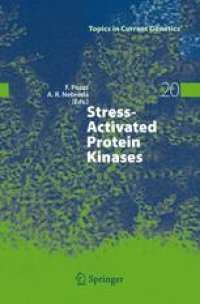
Ebook: Stress-Activated Protein Kinases
- Tags: Biochemistry general, Cell Biology, Molecular Medicine
- Series: Topics in Current Genetics 20
- Year: 2008
- Publisher: Springer-Verlag Berlin Heidelberg
- Edition: 1
- Language: English
- pdf
To maximize the probability of survival, cells need to coordinate their intracellular activities in response to changes in the extracellular environment. MAP kinase cascades play an important role in the transduction of signals inside eukaryotic cells. In particular, stress stimuli result in the rapid activation of a highly conserved group of MAP kinases, known as SAPKs (Stress-Activated Protein Kinases). These kinases coordinate the generation of adaptive responses that are essential for cell survival, which include the modulation of several aspects of cell physiology from metabolism to gene expression.
In this book, leading researchers in the field discuss the state-of-the-art of many aspects of SAPK signalling in various systems from yeast to mammals. These include various chapters on regulatory mechanisms as well as the contribution of the SAPK signalling pathways to processes such as gene expression, metabolism, cell cycle regulation, immune responses and tumorigenesis.
To maximize the probability of survival, cells need to coordinate their intracellular activities in response to changes in the extracellular environment. MAP kinase cascades play an important role in the transduction of signals inside eukaryotic cells. In particular, stress stimuli result in the rapid activation of a highly conserved group of MAP kinases, known as SAPKs (Stress-Activated Protein Kinases). These kinases coordinate the generation of adaptive responses that are essential for cell survival, which include the modulation of several aspects of cell physiology from metabolism to gene expression.
In this book, leading researchers in the field discuss the state-of-the-art of many aspects of SAPK signalling in various systems from yeast to mammals. These include various chapters on regulatory mechanisms as well as the contribution of the SAPK signalling pathways to processes such as gene expression, metabolism, cell cycle regulation, immune responses and tumorigenesis.
To maximize the probability of survival, cells need to coordinate their intracellular activities in response to changes in the extracellular environment. MAP kinase cascades play an important role in the transduction of signals inside eukaryotic cells. In particular, stress stimuli result in the rapid activation of a highly conserved group of MAP kinases, known as SAPKs (Stress-Activated Protein Kinases). These kinases coordinate the generation of adaptive responses that are essential for cell survival, which include the modulation of several aspects of cell physiology from metabolism to gene expression.
In this book, leading researchers in the field discuss the state-of-the-art of many aspects of SAPK signalling in various systems from yeast to mammals. These include various chapters on regulatory mechanisms as well as the contribution of the SAPK signalling pathways to processes such as gene expression, metabolism, cell cycle regulation, immune responses and tumorigenesis.
Content:
Front Matter....Pages I-XVIII
MAPK Kinase Kinase Regulation of SAPK/JNK Pathways....Pages 1-15
Alternative p38 MAPK Pathways....Pages 17-32
The regulation of stress-activated MAP kinase signalling by protein phosphatases....Pages 33-49
Transcriptional regulation by the p38 MAPK signaling pathway in mammalian cells....Pages 51-79
Regulation of gene expression in response to osmostress by the yeast stress-activated protein kinase Hog1....Pages 81-97
Regulation of Tumorigenesis by p38? MAP Kinase....Pages 99-128
Control of Cell Cycle by SAPKs in Budding and Fission Yeast....Pages 129-140
Hog1-mediated Metabolic Adjustments Following Hyperosmotic Shock in the Yeast Saccharomyces cerevisiae ....Pages 141-158
Control of mRNA Stability by SAPKs....Pages 159-170
Intrinsically Active (MKK-Independent) Variants of SAPKs – How do They Work?....Pages 171-186
Regulation of MAPK Signaling in Yeast....Pages 187-204
Modeling the Dynamics of Stress Activated Protein Kinases (SAPK) in Cellular Stress Response....Pages 205-224
Stress-activated Protein Kinase Signaling in Drosophila ....Pages 225-241
Protein Kinases as Substrates for SAPKs....Pages 243-260
Functions of stress-activated MAP kinases in the immune response....Pages 261-281
Stress-activated MAP Kinases in Chromatin and Transcriptional Complexes....Pages 283-297
SAPK and Translational Control....Pages 299-310
Back Matter....Pages 311-312
To maximize the probability of survival, cells need to coordinate their intracellular activities in response to changes in the extracellular environment. MAP kinase cascades play an important role in the transduction of signals inside eukaryotic cells. In particular, stress stimuli result in the rapid activation of a highly conserved group of MAP kinases, known as SAPKs (Stress-Activated Protein Kinases). These kinases coordinate the generation of adaptive responses that are essential for cell survival, which include the modulation of several aspects of cell physiology from metabolism to gene expression.
In this book, leading researchers in the field discuss the state-of-the-art of many aspects of SAPK signalling in various systems from yeast to mammals. These include various chapters on regulatory mechanisms as well as the contribution of the SAPK signalling pathways to processes such as gene expression, metabolism, cell cycle regulation, immune responses and tumorigenesis.
Content:
Front Matter....Pages I-XVIII
MAPK Kinase Kinase Regulation of SAPK/JNK Pathways....Pages 1-15
Alternative p38 MAPK Pathways....Pages 17-32
The regulation of stress-activated MAP kinase signalling by protein phosphatases....Pages 33-49
Transcriptional regulation by the p38 MAPK signaling pathway in mammalian cells....Pages 51-79
Regulation of gene expression in response to osmostress by the yeast stress-activated protein kinase Hog1....Pages 81-97
Regulation of Tumorigenesis by p38? MAP Kinase....Pages 99-128
Control of Cell Cycle by SAPKs in Budding and Fission Yeast....Pages 129-140
Hog1-mediated Metabolic Adjustments Following Hyperosmotic Shock in the Yeast Saccharomyces cerevisiae ....Pages 141-158
Control of mRNA Stability by SAPKs....Pages 159-170
Intrinsically Active (MKK-Independent) Variants of SAPKs – How do They Work?....Pages 171-186
Regulation of MAPK Signaling in Yeast....Pages 187-204
Modeling the Dynamics of Stress Activated Protein Kinases (SAPK) in Cellular Stress Response....Pages 205-224
Stress-activated Protein Kinase Signaling in Drosophila ....Pages 225-241
Protein Kinases as Substrates for SAPKs....Pages 243-260
Functions of stress-activated MAP kinases in the immune response....Pages 261-281
Stress-activated MAP Kinases in Chromatin and Transcriptional Complexes....Pages 283-297
SAPK and Translational Control....Pages 299-310
Back Matter....Pages 311-312
....